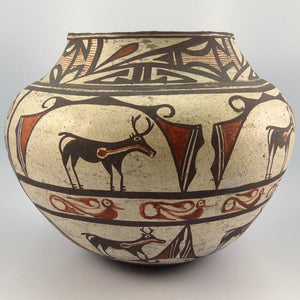Pottery
3 products
3 products

Pueblo pottery dates back as far as 150 CE and was entirely utilitarian. The arrival of railroads and tourists caused the emergence of pottery as art. Not only is pottery beautiful to look at, but it is also very remarkable that the pottery artists of today make their pots in the same manner that their ancestors did hundreds or thousands of years ago.
The clay to make the pots is still being gathered at historic sites near their pueblos. After gathering the clay and painstakingly preparing it, the potters form the coils, or ropes, of clay and shape the pot coil by coil. Then the pot is dried, scraped with a piece of gourd, sanded, and slipped with a fine clay mixture. The pot is polished over and over with a polishing stone often handed down from generation to generation. The skillful polisher gives the pot its lasting and beautiful sheen. Pueblo pottery is hand-coiled, and no wheel is used – which makes the perfect symmetry of the pots even more impressive. Pots are still traditionally fired in an open pit fire outdoors utilizing slabs of wood for fuel. The fire can be smothered with sheep manure to turn the clay a deep black color.
Santa Clara (often carved) and San Ildefonso pottery are usually red or black. If a pot is to be painted (e.g. Hopi or Acoma pottery) the potters make their own vegetal or mineral paints; using the blade of a yucca cactus, they paint their designs freehand. Many artists still hand paint their designs with natural pigments from materials gathered near their homes. The traditional potters fire their pots in a homemade oven built outdoors.
Subscribe to our newsletter!







